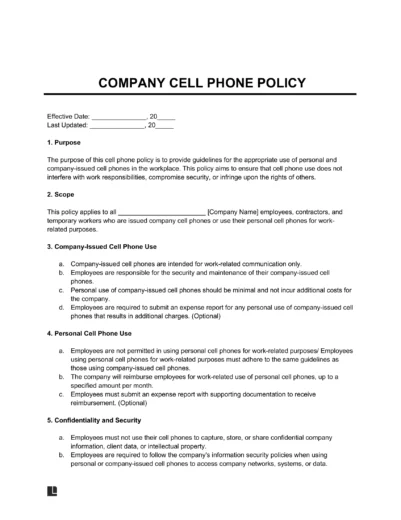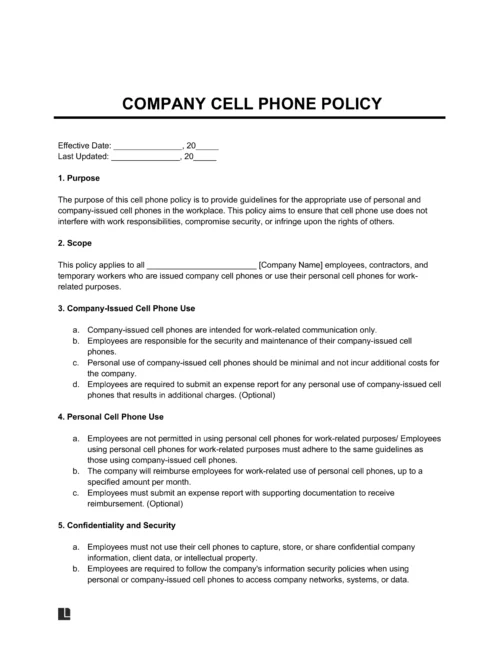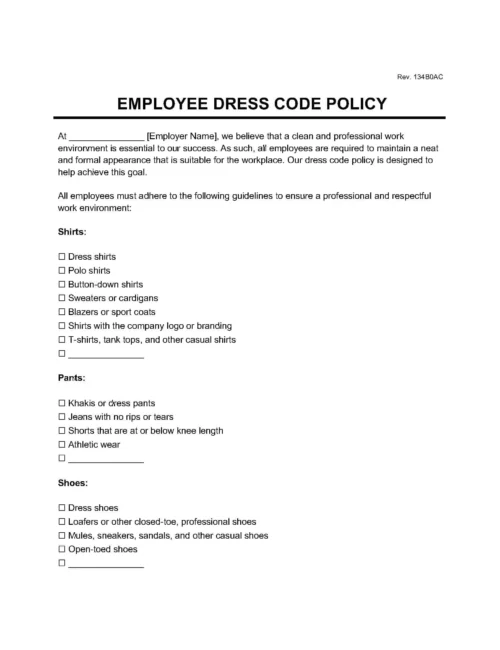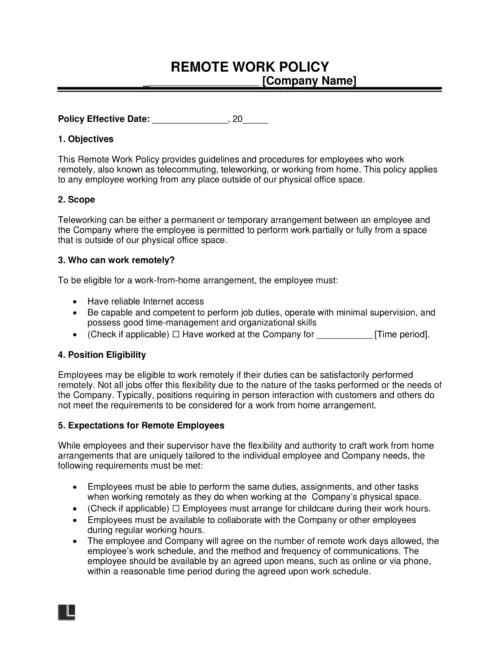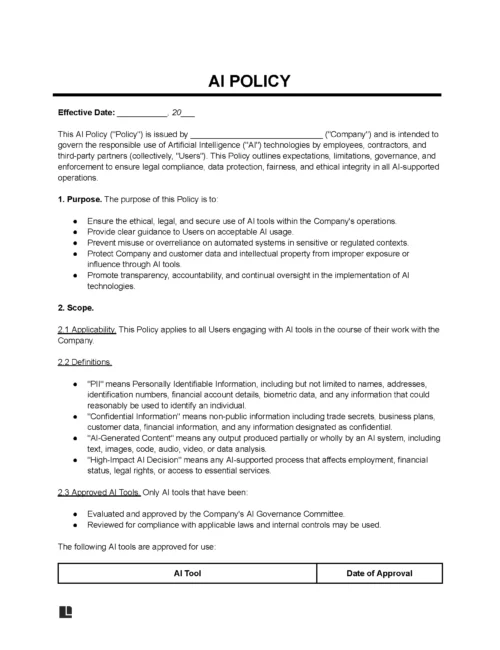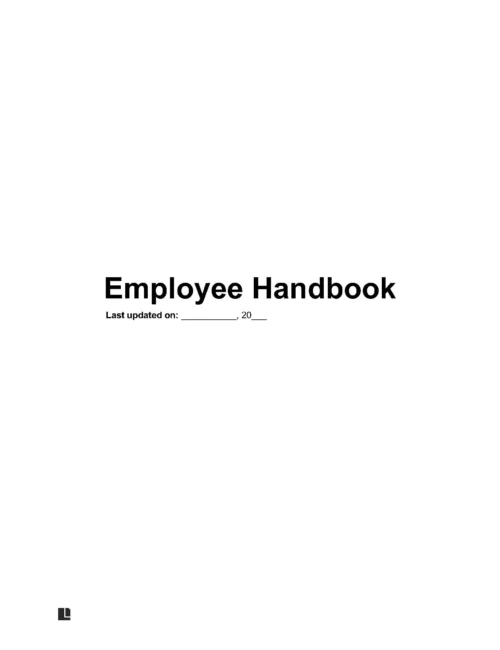A company policy form is a document that delineates a company’s expectations for behavior, activities, and procedures. It is critical for creating clear employee expectations, which improves morale and accountability.
A well-written company policy can also provide crucial legal protection in a labor dispute. Documenting company policies ensures that both employers and employees understand how to handle certain situations or conflicts that may arise.
By Type
Company policy forms differ depending on your business’s specific needs.
Use to establish clear guidelines and standards for an organization’s use of artificial intelligence
AI Policy
Employee Handbook
An employee handbook is a comprehensive company policy document incorporating employment-related policies and procedures.
It often details the company’s mission and values while establishing a standard code of conduct. Depending on the business, the employee handbook may also define the company’s culture and vision.
Employees with access to a comprehensive employee handbook understand how to comport themselves consistently with the company’s expectations.
They can work confidently, knowing they meet their employer’s requirements.
Employers benefit from having a single source of policies and procedures that hold everyone to a consistent standard. This allows employers to enforce policies while reducing the risk of discrimination or favoritism.
Importance of Company Policies
Company policies should be delineated for each situation. A well-established, comprehensive company policy can offer the following benefits:
Provides Clarity and Consistency
Company policies provide clear instructions regarding how employees should act when performing work-related activities inside or outside the workplace.
The documents also outline how employees should perform their jobs, what they should wear, and how to file a grievance or complaint. With clear and consistent expectations, employees know what to do on the job.
This clarity provides them with greater stability and enhances job satisfaction.
At the same time, policies provide supervisors and employers with acceptable guidelines for employee behavior. This can help prevent employers from engaging in unfair treatment or expecting different behavior from different employees.
Supports Legal Compliance
Legally, having a policy ensures that employers and employees meet legal requirements for creating a safe work environment. A clear written policy signed by an employee is documented evidence that the employee is aware of their expected behavior or actions.
If an employee fails to comply with standard policies and procedures, the employer has grounds to discipline the employee consistent with company policies.
Similarly, employees held to inconsistent standards or mistreated can point to clear policies and procedures when filing a grievance.
Enhances Employee Morale and Retention
Establishing clear company policies can help your business thrive. Employees who understand their roles and expectations are likelier to stay with the company.
Companies with clear policy and procedure documents retain top talent and reduce costly turnover. Moreover, studies show that happier employees are more productive. [1]
With well-trained, satisfied employees, your business can grow while reducing the costs of recruiting, hiring, and training new workers.
Manages Risks
Employers can reduce their potential liability with clear policies and procedures for potential legal matters like workplace harassment, discrimination, confidentiality, and fraud.
Clear policies and procedures also mitigate health and safety risks in the workplace. For instance, establishing policies and procedures consistent with Occupational Safety and Health Administration (OSHA) standards can reduce the risk of injury or illness on the job.
Streamlines Decision Making
Your policies and procedures establish processes for internal decision-making. When all stakeholders understand a given process, they save time determining how to move forward or negotiating the next steps.
In addition, policies and procedures set parameters for acceptable and unacceptable outcomes. For example, if an employee fails to meet an established metric for completed tasks, they are aware of the consequences, as is their supervisor.
This opens the door for more productive communication and coaching opportunities.
Improves Communication
Business communication is much easier when everyone agrees to abide by specific policies and procedures. With established company policies, employers, managers, and workers can communicate their expectations, ask questions, and air grievances within those guidelines.
Company-specific policies and procedures can also establish communication methods, lines of communication, and appropriate terminology. This helps people within the organization understand whom to contact, how to contact them, and how to communicate their message. [2]
Establishes Company Culture
Work culture addresses the beliefs and attitudes of employees within the company.
Recent studies indicate that employees are happier and more productive in a positive work culture. [3] Employees thrive in a work environment where open communication, collaboration, and cooperation are part of the company culture.
Policies and procedures to establish a positive work culture can help maximize your company’s potential and drive higher productivity.
How to Create an Effective Company Policy
An effective company policy can boost business productivity, reduce legal liability, and enhance employee satisfaction. Follow these steps to create the perfect company policy documents for your needs:
Step 1 – Understand the Purpose and Identify Your Stakeholders
When establishing company policies and procedures, you will likely need different policies to address different situations. Begin the policy creation process by understanding the reason for the policy.
For example, you may need to create a dress code policy for your retail establishment to ensure employees wear professional attire or company uniforms while working.
You must also determine who the stakeholders are for each policy. For a cell phone policy, consider who the policy addresses and who may be required to enforce it.
If the procedure involves other parties, such as management or human resources, include them.
Step 2 – Research Legal Requirements
An effective policy should be built upon external legal resources and requirements. A legal template can help ensure you cover some of the legal requirements.
Establishing a link to reliable legal sources enhances your policy’s credibility and enforceability.
If you have questions about legal requirements for a particular policy, don’t guess. Consult with an attorney or other legal professional with experience handling business policies.
Step 3 – Create Your Draft
Use a company policies template rather than trying to draft your documents from scratch. Fill in the necessary details and add policy information specific to your company.
A template helps you include critical policy details and streamlines the draft process.
Step 4 – Use Clear and Simple Language
When creating a company policy, it can be easy to get bogged down in legal jargon. You want your guidelines to be clear so all stakeholders understand their responsibilities and obligations.
While you may include specific legal language to protect your company, you also want employees to understand what is expected of them. Clear policy language can also protect your business from claims that the policy is too hard to understand.
Step 5 – Review and Get Feedback
Once you have completed your policy, seek feedback from your legal counsel, company leadership, and employees who may be affected by the policy. This step is critical to ensuring that the policies and procedures outlined are functional within the scope of business.
With feedback from all stakeholders, you can determine whether your policy should be updated before implementation.
This final review can save you from expensive mistakes or time-consuming trial-and-error. It also encourages affected employees to participate, fostering cooperation and collaboration.
Step 6 – Implement and Update Regularly
After completing your final review, distribute the new policies and procedures to your employees and implement them as stated in your documents. Expect questions and mistakes as employees become used to the new processes.
No policy is good forever. Be sure to review your policies and procedures regularly and keep them up to date with changing legal and operational requirements.
Frequently Asked Questions
What is a company policy?
A company policy is a document or series of documents that define the obligations and responsibilities of a company and its workers.
Company policies and procedures may include dress codes and harassment, cell phone, and social media policies.
What should a company policy include?
Company policy forms should include the following elements:
- A statement of the policy’s purpose
- Definitions of potentially confusing terminology
- Step-by-step instructions or policy guidelines
- Explanation of expected behavior related to the company policy
- Description of prohibited behaviors related to the policy
- Consequences for failure to adhere to the policy
- Steps to take if someone violates the company policy
How often should company policies be reviewed and updated?
Ideally, you should update your policies and procedures whenever an internal or external change occurs that could affect how employees understand or enforce them.
For example, if a recent legislative session resulted in laws that affect your harassment policy, you should update that document as soon as possible.
If no legal updates or internal changes arise, consider reviewing and updating each policy annually to avoid overlooking essential changes.
Who should be involved in creating company policies?
Depending on the policy, including all stakeholders in the review process for new policies may be wise. Company policies can involve many internal stakeholders, including employees, managers, supervisors, and upper management.
External stakeholders, such as product manufacturers, suppliers, or distributors, may also provide valuable information that could affect your new policy. Be sure to consult with everyone involved to avoid costly oversights.
What happens if a company policy is violated?
Consequences for violating company policies can vary depending on your company’s internal policy and external legal requirements.
For internal company policies that do not threaten the safety or legality of company operations, you may employ internal procedures, such as coaching, verbal warnings, written warnings, and termination.
Company policies with legal requirements, such as harassment or discrimination policies, may include more severe consequences in the event of a violation.
For instance, the company may punish an employee who commits an illegal activity with a demotion or job termination. They may also undergo legal scrutiny and face criminal or civil charges, depending on the severity of their legal violation.
If you have questions about legal policies, speak with a lawyer in your area who specializes in business policies and practices.
